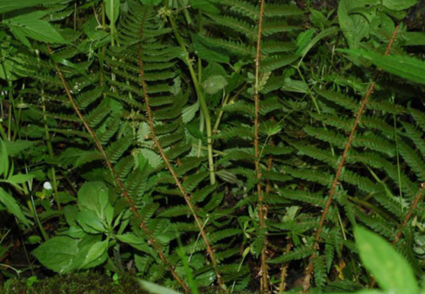Abstract
Polystichum gonggashanense (Dryopteridaceae: sect. Hypopeltis) is described and illustrated from Mt. Gongga (Minyar Gonkar), Sichuan, China. It can be distinguished from its most similar species, P. sinense, by the blackish brown petiole scales, the oblong-lanceolate lamina, and narrowly lanceolate rachis scales. The new species is found in four populations each with a few individuals and one of the populations has already disappeared. It is classified as CR (Critically Endangered) category based on the IUCN criteria.
References
Baroni, E. & Christ, H. (1901) Filices plantaeque filicibus affines in Shan-si septentrionali, provinceae Imperii Sinensis, a Rev. Patre Josepho Giraldi collectae. Nuovo Giornale Botanico Italiano, n. ser. 10: 288–292.
Brackenridge, W.D. (1854) Botany. Cryptogamia. Filices, including Lycopodiaceae and Hydropterides. In: Wilkes, C. (Ed.) United States Exploring Expedition. During the years 1838, 1839, 1840, 1841, 1842. Under the command of Charles Wilkes, U.S.N., vol. 16. pp. 1–357.
Christ, H. (1905) Les collections de fougères de la Chine au Muséum d’Histoire Naturelle de Paris. Bulletin de la Societe Botanique de France 52 (Memoires 1): 1–69. https://doi.org/10.1080/00378941.1905.10829209
IUCN Standards and Petitions Committee (2019) Guidelines for Using the IUCN Red List Categories and Criteria. Version 14. Prepared by the Standards and Petitions Committee. Available from: http://www.iucnredlist.org/documents/RedListGuidelines.pdf (Accessed 28 December 2021).
Le Péchon, T., He, H., Zhang, L., Zhou, X.-M., Gao, X.-F. & Zhang, L.-B. (2016a) Using a multilocus phylogeny to test morphology-based classifications of one of the largest fern genera Polystichum (Dryopteridaceae). BMC Evolutionary Biology 16: 55. https://doi.org/10.1186/s12862-016-0626-z
Le Péchon, T., Zhang, L., Zhou, X.-M., He, H., Gao, X.-F. & Zhang, L.-B. (2016b) A well-sampled phylogenetic analysis of the polystichoid ferns (Dryopteridaceae) suggests a complex biogeographical history involving both boreotropical migrations and recent transoceanic dispersals. Molecular Phylogenetics and Evolution 98: 324–336. https://doi.org/10.1016/j.ympev.2016.02.018
Liu, H.-M., Zhang, X.-C., Chen, Z.-D. & Qiu, Y.-L. (2007) Inclusion of the Eastern Asia endemic genus Sorolepidium in Polystichum (Dryopteridaceae): Evidence from the chloroplast rbcL gene and morphological characteristics. Chinese Science Bulletin 52: 631–638. https://doi.org/10.1007/s11434-007-0115-2
Michaux, A. (1803) Flora Boreali-Abericana, sistens carcteres plantarum quas in America septentrionali collegit et detexit Andreas Michaux, vol. 2. Frs. Levrault, Paris & Strasbourg [Parisiis et Argentorati], 340 pp. https://doi.org/10.5962/bhl.title.330
Moore, T. (1857–1862) Index Filicum. W. Pamplin, London, 396 pp.
Roth, A.W. (1800) Tentamen Florae Germanicae, vol. 3. Gleditsch, Leipzig ( Lipsiae), 578 pp.
Wu, C.-Y. (1983) Flora Xizangica, vol. 1. Science Press, Beijing, 791 pp.
Yang, C.-Y. (1992) Flora Xinjiangensis, vol. 1. Xinjiang Science & Technology & Hygiene Publishing House, Urumuqi, 337 pp.
Zhang, L.-B. (2012) Taxonomic and nomenclatural notes on the fern genus Polystichum (Dryopteridaceae) from China. Phytotaxa 60: 57–60. https://doi.org/10.11646/phytotaxa.60.1.8
Zhang, L.-B. & Barrington, D.S. (2013) Polystichum Roth. In: Wu, Z.-Y., Raven, P.H. & Hong, D.-Y. (Eds.) Flora of China, vols. 2–3. Science Press, Beijing & Missouri Botanical Presss, St. Louis, pp. 629–713.
Brackenridge, W.D. (1854) Botany. Cryptogamia. Filices, including Lycopodiaceae and Hydropterides. In: Wilkes, C. (Ed.) United States Exploring Expedition. During the years 1838, 1839, 1840, 1841, 1842. Under the command of Charles Wilkes, U.S.N., vol. 16. pp. 1–357.
Christ, H. (1905) Les collections de fougères de la Chine au Muséum d’Histoire Naturelle de Paris. Bulletin de la Societe Botanique de France 52 (Memoires 1): 1–69. https://doi.org/10.1080/00378941.1905.10829209
IUCN Standards and Petitions Committee (2019) Guidelines for Using the IUCN Red List Categories and Criteria. Version 14. Prepared by the Standards and Petitions Committee. Available from: http://www.iucnredlist.org/documents/RedListGuidelines.pdf (Accessed 28 December 2021).
Le Péchon, T., He, H., Zhang, L., Zhou, X.-M., Gao, X.-F. & Zhang, L.-B. (2016a) Using a multilocus phylogeny to test morphology-based classifications of one of the largest fern genera Polystichum (Dryopteridaceae). BMC Evolutionary Biology 16: 55. https://doi.org/10.1186/s12862-016-0626-z
Le Péchon, T., Zhang, L., Zhou, X.-M., He, H., Gao, X.-F. & Zhang, L.-B. (2016b) A well-sampled phylogenetic analysis of the polystichoid ferns (Dryopteridaceae) suggests a complex biogeographical history involving both boreotropical migrations and recent transoceanic dispersals. Molecular Phylogenetics and Evolution 98: 324–336. https://doi.org/10.1016/j.ympev.2016.02.018
Liu, H.-M., Zhang, X.-C., Chen, Z.-D. & Qiu, Y.-L. (2007) Inclusion of the Eastern Asia endemic genus Sorolepidium in Polystichum (Dryopteridaceae): Evidence from the chloroplast rbcL gene and morphological characteristics. Chinese Science Bulletin 52: 631–638. https://doi.org/10.1007/s11434-007-0115-2
Michaux, A. (1803) Flora Boreali-Abericana, sistens carcteres plantarum quas in America septentrionali collegit et detexit Andreas Michaux, vol. 2. Frs. Levrault, Paris & Strasbourg [Parisiis et Argentorati], 340 pp. https://doi.org/10.5962/bhl.title.330
Moore, T. (1857–1862) Index Filicum. W. Pamplin, London, 396 pp.
Roth, A.W. (1800) Tentamen Florae Germanicae, vol. 3. Gleditsch, Leipzig ( Lipsiae), 578 pp.
Wu, C.-Y. (1983) Flora Xizangica, vol. 1. Science Press, Beijing, 791 pp.
Yang, C.-Y. (1992) Flora Xinjiangensis, vol. 1. Xinjiang Science & Technology & Hygiene Publishing House, Urumuqi, 337 pp.
Zhang, L.-B. (2012) Taxonomic and nomenclatural notes on the fern genus Polystichum (Dryopteridaceae) from China. Phytotaxa 60: 57–60. https://doi.org/10.11646/phytotaxa.60.1.8
Zhang, L.-B. & Barrington, D.S. (2013) Polystichum Roth. In: Wu, Z.-Y., Raven, P.H. & Hong, D.-Y. (Eds.) Flora of China, vols. 2–3. Science Press, Beijing & Missouri Botanical Presss, St. Louis, pp. 629–713.


